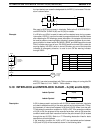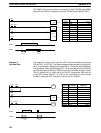
159
Any one TC number cannot be defined twice, i.e., once it has been used as the
definer in any of the timer or counter instructions, it cannot be used again. Once
defined, TC numbers can be used as many times as required as operands in
instructions other than timer and counter instructions.
TC numbers run from 000 through 511. No prefix is required when using a TC
number as a definer in a timer or counter instruction. Once defined as a timer, a
TC number can be prefixed with TIM for use as an operand in certain instruc-
tions. The TIM prefix is used regardless of the timer instruction that was used to
define the timer. Once defined as a counter, a TC number can be prefixed with
CNT for use as an operand in certain instructions. The CNT is also used regard-
less of the counter instruction that was used to define the counter.
TC numbers can be designated as operands that require either bit or word data.
When designated as an operand that requires bit data, the TC number accesses
a bit that functions as a ‘Completion Flag’ that indicates when the time/count has
expired, i.e., the bit, which is normally OFF, will turn ON when the designated SV
has expired. When designated as an operand that requires word data, the TC
number accesses a memory location that holds the present value (PV) of the
timer or counter. The PV of a timer or counter can thus be used as an operand in
CMP(20), or any other instruction for which the TC area is allowed. This is done
by designating the TC number used to define that timer or counter to access the
memory location that holds the PV.
Note that “TIM 000” is used to designate the TIMER instruction defined with TC
number 000, to designate the Completion Flag for this timer, and to designate
the PV of this timer. The meaning of the term in context should be clear, i.e., the
first is always an instruction, the second is always a bit operand, and the third is
always a word operand. The same is true of all other TC numbers prefixed with
TIM or CNT.
An SV can be input as a constant or as a word address in a data area. If an IR
area word assigned to an Input Unit is designated as the word address, the Input
Unit can be wired so that the SV can be set externally through thumbwheel
switches or similar devices. Timers and counters wired in this way can only be
set externally during RUN or MONITOR mode. All SVs, including those set ex-
ternally, must be in BCD.
5-14-1 TIMER – TIM
N: TC number
# (000 through 511)
Ladder Symbol
Definer Values
SV: Set value (word, BCD)
IR, AR, DM, HR, LR, #
Operand Data Areas
TIM N
SV
Limitations SV is between 000.0 and 999.9. The decimal point is not entered.
Each TC number can be used as the definer in only one TIMER or COUNTER
instruction.
TC 000 through TC 015 should not be used in TIM if they are required for
TIMH(15). Refer to 5-14-2 HIGH-SPEED TIMER – TIMH(15) for details.
Description A timer is activated when its execution condition goes ON and is reset (to SV)
when the execution condition goes OFF. Once activated, TIM measures in units
of 0.1 second from the SV.
Timer and Counter Instructions Section 5-14


















